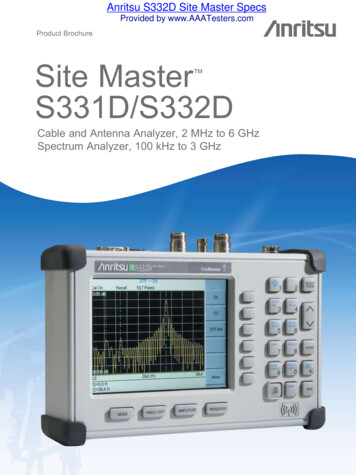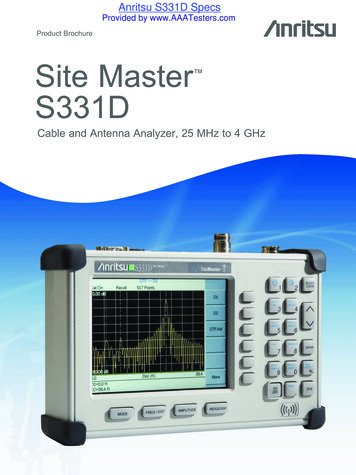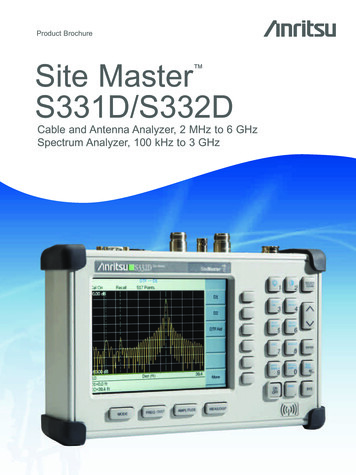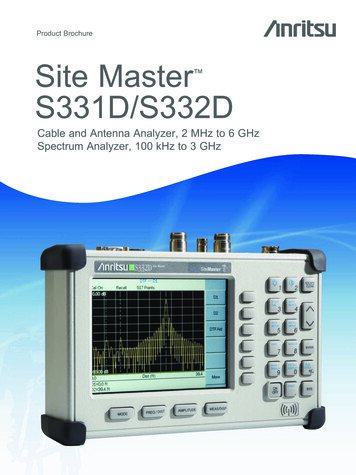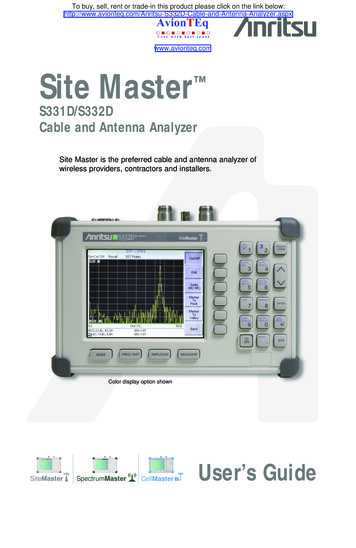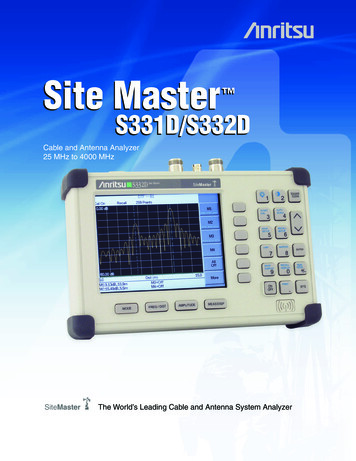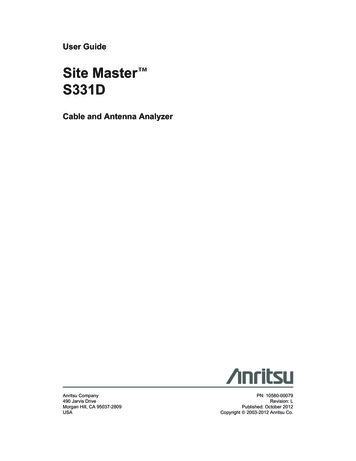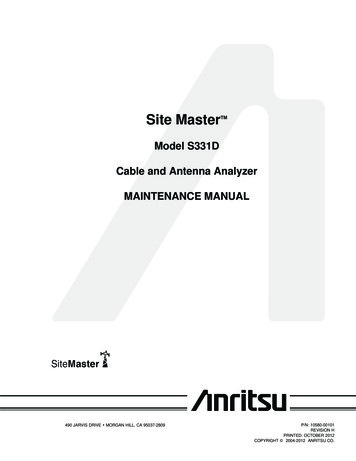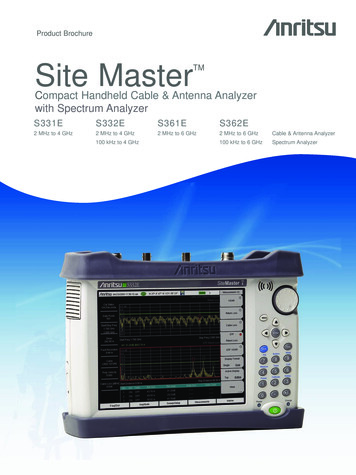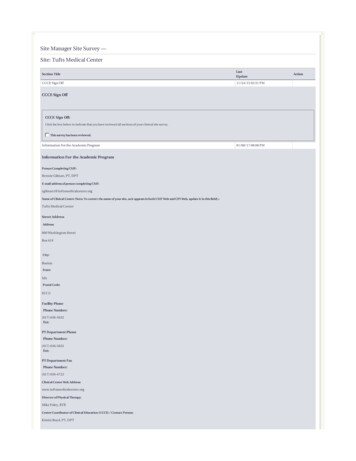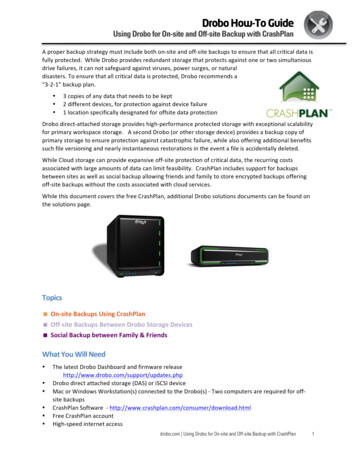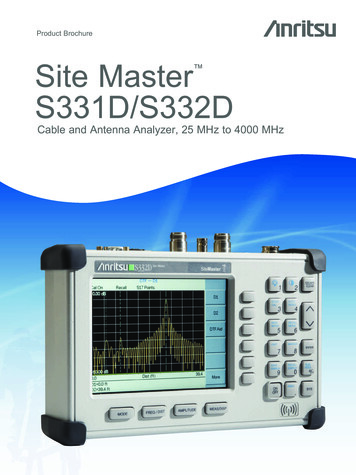
Transcription
Product BrochureSite MasterS331D/S332D Cable and Antenna Analyzer, 25 MHz to 4000 MHz
Site Master is the Preferred Cable and Antenna Analyzerof Wireless Service Providers, Contractors, and Installers.Cost Savings and Quality ImprovementWireless market competition requires operators to reduce per site maintenanceexpense. Site Master’s Frequency Domain Reflectometry (FDR) techniquesbreak away from the traditional fix-after-failure maintenance process by findingsmall, hard to identify problems before major failures occur.Sixty to eighty percent of a typical cell site’s problems are caused by problematiccables, connectors and antennas. When cables or antennas are contaminatedwith moisture, damaged, or mispositioned during storms, Site Master identifiesthe problem quickly. Antenna degradation reduces the cell coverage pattern andcan cause dropped calls. Site Master can pinpoint the antenna problem fromground level in a few seconds making climbing the antenna tower unnecessary.A poorly installed weather seal will corrode connectors and, if undetected, willeventually damage an expensive coaxial cable. Site Master has the sensitivity toidentify the connector problem before the cable is damaged. Distance-To-Faultprovides the clearest indication of troubled areas.Site MasterRevolutionizesCable andAntennaSweeping inthe WirelessIndustry.Rugged and ReliableBecause the Site Master was designed specifically for field environments,it can easily withstand the day-to-day punishment of field use. The analyzer isalmost impervious to the bumps and bangs typically encountered by portablefield-equipment.Easy-to-UseSite Master operation is straightforward; measurements are obtained through amenu-driven user interface that is easy to use and requires little training. Thelarge, and high-resolution TFT color display makes test interpretation easy andquick. A full range of markers enable the user to make accurate measurements.Limit lines simplify measurements allowing users to create quick and simplepass/fail tests.Features local language graphical user interface support in English,Chinese, Japanese, French, German, and Spanish.2
External DC Power PortRS-232 InterfaceTransfer stored data to and from a personalcomputer (PC) or download to a printer via aserial cable for further analysis. Use PC toautomatically control and collect data in the field.Spectrum Analyzerand Power Meter PortExternal Trigger andExternal Reference InCable and Antenna Analyzer PortT1/E1 Receive and Transmit PortS331D Models with Option 50.Frequency Converter Module PortOption 6 (S332D) for control of anexternal frequency extension module.Snap-in Fieldreplaceable batterylocationSave and Recall SetupSave setups for fast repeatabletesting:S332D Models - 20S331D Models - 25Rugged and ReliableChassis DesignRuggedized, lightweight, compact,high-impact housing is designed towithstand repeated drops and roughhandling. Weather resistant sealsand rubber membrane keypadprotect unit from dirt and moisture.MarkersSix markers for more comprehensivemeasurements.LimitsCreate simple pass/failmeasurements with a single limit line,upper and/or lower mask limit lines.TFT Color DisplayStandard TFT (640 x 480) colordisplay featuring variable brightnesscontrol. Viewable in direct sunlight.Function KeysFour dedicated function keys simplifymeasurement tasks.Multilingual User InterfaceMulti-language user interfacefeatures on-screen menus andmessages in six different languages:Chinese, English, French, German,Japanese, Spanish.Soft KeysIntuitive soft key menuand user interface.Save and Recall DisplayUp to 300 memory locations. Alphanumericdata labeling and automatic time/datestamp simplify data management.FunctionAM/FM Receiver with Internal SpeakerBuilt-in AM/FM demodulator enables testing andtrouble-shooting of wireless communications systems.An internal speaker and jack are included.BenefitsCable and Antenna Analyzer (331D/S332D)Characterize antenna system and pinpoint location of faultsSpectrum Analyzer (S332D)Easily locate, identify and record various signals with high accuracyAM/FM Demodulator (S332D)Built-in demodulator for AM, narrow band FM, wide band FM, and SSB allows technician to listen to andidentify interfering signalsStandard TFT Color Display (S331D/S332D)Display is viewable in direct sunlightPower Monitor (S331D/S332D)Performs accurate broadband power measurements using an external detectorHigh Accuracy Power MeterPerforms accurate RMS power measurements for both CW and modulated signalsPower Meter (S331D/S332D)Performs accurate power measurements up to 3 GHz without the need of an external detectorFrequency Converter Interface (S332D)Make measurement from 4.7 to 6 GHz using an external detectorBuilt-in 12 to 24V variable Bias Tee (S332D)No need to use external power to bias an amplifierTransmission Measurement (S332D)Perform a 2-port scalar measurements and measure the insertion gain, loss, and isolation of TowerMounted Amplifiers, filters, attenuators, and antennas.Interference Analyzer (S332D)Identify and locate interfering signals that cause dropped calls and coverage problems. Intermittentproblems can be identified using spectrogramsChannel Scanner (S332D)Measure frequency, bandwidth and power of multiple transmitted signalsCW Signal Generator (S332D)CW source to test low noise amplifiersGPS Receiver (S331D/S332D)Provides location (latitude, longitude, altitude) and UTC time informationT1/E1 Analyzer (S331D)Simplifies the task of determining if the source of problems is on the wireline or the wireless side3
Cable and Antenna Analysis – Increase System UptimeFDR TechniqueFrequency Domain Reflectometry, (FDR), and Time Domain Reflectometry, (TDR), have similar acronyms, and bothtechniques are used to test transmission lines. But, that’s where the similarities end. TDRs are not sensitive to RFproblems: the TDR stimulus is a DC pulse, not RF. Thus, TDRs are unable to detect system faults that often lead tosystem failures. Additionally, FDR techniques save costly, time-consuming trouble shooting efforts by testing cablefeed-line and antenna systems at their proper operating frequency. Deficient connectors, lightning arrestors, cables,jumpers, or antennas are replaced before call quality is compromised.Quick, Simple MeasurementsSite Master performs various RF measurements aimed at simplifying cable feedline and antenna analysis: ReturnLoss, SWR, Cable Loss and Distance-to-Fault (DTF). A single key selection on the main menu activates the desiredmeasurement mode.Return Loss, SWRReturn Loss and SWR “system" measurements ensure conformance tosystem performance engineering specifications. Measurement easily togglesbetween either one of the two modes and can be performed withoutclimbing the tower.Cable LossCable Loss measurements measure the level of insertion loss within thecable feed-line system. Insertion loss can be verified prior to deployment,when you have access to both ends of the cable, or on installed cableswithout access to the opposite end. Site Master automatically calculatesand displays the average cable loss so there is no more guess work or aneed to perform calculations in the field.Distance-to-FaultAlthough a Return Loss test can tell users the magnitude of signal reflections,it cannot tell the precise location of a fault within the feed-line system.Distance-To-Fault measurements provide the clearest indication of trouble areasas it tells us both the magnitude of signal reflection and the location of thesignal anomaly.Distance-To-Fault measurement capability is built into all Site Master modelsas a standard feature. Return Loss (SWR) measurement data is processed usingFast Fourier Transform and the resulting data indicates Return Loss (SWR)versus distance. Distance-to-Fault measurements indicating Return Loss orSWR versus time is available with Handheld Software Tools . 4
OSL CalibrationOpen-Short-Load (OSL) calibration is standard for the S331D and S332D. All errors from source match, directivityand frequency response are mathematically removed allowing for accurate vector corrected Return Loss, Cable Loss,VSWR, and DTF measurements. Directivity is usually the main contributor to measurement uncertainty, andcorrected directivity of 42 dB or better is common using Anritsu’s precision components.FlexCal TMThe Site Master FlexCal broadband calibration feature is an OSL-based calibration method. It offers fieldtechnicians a simple and convenient way to troubleshoot and identify faulty antenna system components, because iteliminates the need for multiple instrument calibrations and calibration setups. Field technicians can now perform abroadband calibration from 25 MHz to 4 GHz and change the frequency range after calibration without having torecalibrate the instrument. A zoom-in/zoom-out capability is available in Return Loss, Cable Loss or VSWR mode.Because the resolution and maximum distance are dependent on the frequency range, field technicians can evenchange the frequency range in DTF mode to produce the desired fault resolution and horizontal range needed for themeasurement, without performing additional calibrations.InstaCal CalibrationThe InstaCal Calibration module is available for the S331D and S332D and users can cutthe time required to calibrate the Site Master by as much as 50 percent. WithInstaCal, users are only required to connect the InstaCal calibrationmodule once and the calibration process will be done automatically.Directivity specification for the InstaCal module is 38 dB for the entirefrequency range allowing the user to make fast and accurate measurements.RF ImmunityIn today’s wireless environment it is very common that there will be other RF activity present when making ameasurement. In order to make accurate measurements in hostile RF environments, the receiver has to be able toreject the unwanted signals. Special dithering techniques are applied to the Site Master when making a measurement,and the Site Master can reject signals up to 17 dBm ensuring accurate measurements in RF rich environments.5
Spectrum Analysis – Anywhere, Anytime (S332D)The Site Master S332D integrated Spectrum Analysis capability provides the “ultimate” in measurement flexibility forfield environments and applications requiring mobility. With the S332D you can locate, identify, record and solvecommunication systems problems quickly and easily, and with incredible accuracy – making it a perfect solution forconducting field measurements in the 100 kHz to 3 GHz frequency range.One Button MeasurementsThe S332D has dedicated routines for one-button measurements of field strength, channel power, occupiedbandwidth, Adjacent Channel Power Ratio (ACPR), Carrier-to-Interference, and interference analysis. These areincreasingly critical measurements for today’s wireless communication systems. The simple interface for these complexmeasurements significantly reduces test time and increases analyzer usability.Occupied BandwidthThis measurement calculates the bandwidth containing the total integratedpower occupied in a given signal bandwidth. There are two differentmethods of calculation depending on the technique used to modulatethe carrier. The user can specify percent of power or the “x” dB downpoint, where “x” can be from 1 dB to 120 dB below the carrier.Adjacent Channel Power RatioA common transmitter measurement is that of adjacent channel leakagepower. This is the ratio of the amount of leakage power in an adjacentchannel to the total transmitted power in the main channel. Thismeasurement is used to replace the traditional two-tone intermodulationdistortion (IMD) test for system non-linear behavior.The result of an ACPR measurement can be expressed either as a powerratio or a power density. In order to calculate the upper and lower adjacentchannel values, the S332D allow the adjustment of four parameters to meetspecific measurement needs: main channel center frequency, measurementchannel bandwidth, adjacent channel bandwidth and channel spacing.When an air interface standard is specified in the S332D, all these valuesare automatically set to the normal values for that standard.AM/FM/SSB DemodulatorA built-in demodulator for AM, narrowband FM, wideband FM andsingle sideband (selectable USB and LSB) allow a technician to easilyidentify interfering signals.Frequency ConverterControl Module6 GHz MeasurementsThe FCN4760 is a block down converter for the 4.7 to 6.0 GHz frequency range.It is designed to work with an Anritsu Site Master S332D equipped with Option 6.This converter is primarily intended for field use by fixed wireless engineers who are responsible for the design,deployment and optimization of 802.11a networks. It is also used to conduct interference analysis measurementsto determine the level of interference and locate the sources of interference.6
Site Master OptionsPower Monitor (Option 5, S331D and S332D)Use Anritsu’s 560 and 5400 series detector to measurebroadband power. They are an excellent solution tomeasure an 18 GHz microwave link carrying the BaseStation T1/E1 link. The detectors use precision highreturn loss detectors with excellent impedance matchdesigned to minimize mismatch uncertainty(See uncertainty curves on page 11). Measurement rangeis from –50 to 16 dBm and the display range is from–80 to 80 dBm. There are several detectors availabledesigned for different frequency ranges.High Accuracy Power Meter (Option 19)HoldAnritsu’s PSN50 sensor makes high accuracy power measurement from50 MHz to 6 GHz. The sensor provides true RMS measurements from–30 to 20 dBm enabling users to make accurate measurements for CWand digitally modulated signals such as CDMA/EV-DO, GSM/EDGE,and WCDMA/HSDPA. The sensor is equipped with an RS-232 interfacefor fast and easy connection to the Site Master. Power is displayed inboth dBm and Watts. Upper and lower limits can be turned on forPass/Fail measurements.Power Meter(Option 29, S331D and S332D)The power meter
It is designed to work with an Anritsu Site Master S332D equipped with Option 6. This converter is primarily intended for field use by fixed wireless engineers who are responsible for the design, deployment and optimization of 802.11a networks. It is also used to conduct interference analysis measurements to determine the level of interference and locate the sources of interference. Spectrum .
